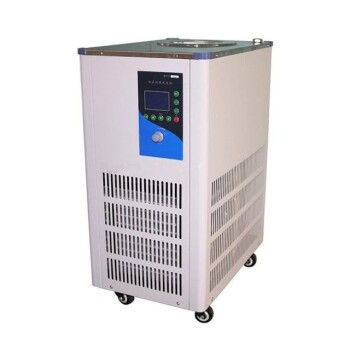A diffusion pump typically operates at high temperatures due to the heating of the diffusion pump oil, which is essential for its functioning. The heater in the pump heats the oil to its boiling point, which can range between 200°C to 300°C (392°F to 572°F), depending on the type of oil used. The boilerplate, where the oil is heated, reaches these temperatures to ensure the oil vaporizes and creates the necessary vapor jets for vacuum generation. The exterior of the pump, including the condensing coils, remains cooler as they are designed to condense the oil vapor back into liquid form. The exact temperature depends on the pump design, oil type, and operational requirements.
Key Points Explained:

-
Operating Principle of a Diffusion Pump:
- Diffusion pumps rely on the heating of diffusion pump oil to generate vapor jets. These jets capture air molecules and create a high vacuum by moving them downward, where they are expelled at the base of the pump.
- The process involves no moving parts, making the pump durable and reliable for high-vacuum applications.
-
Temperature of the Heater and Boilerplate:
- The heater in a diffusion pump heats the boilerplate to temperatures between 200°C to 300°C (392°F to 572°F). This is necessary to boil the diffusion pump oil, which then vaporizes and forms the high-speed vapor jets.
- The exact temperature depends on the type of oil used. For example, silicone-based oils typically boil at higher temperatures compared to hydrocarbon-based oils.
-
Temperature of the Oil Vapor:
- The oil vapor generated by the heater travels upward through the pump's jet openings. The temperature of the vapor is close to the boiling point of the oil, typically in the range of 200°C to 300°C.
- The vapor condenses upon contact with the cooler exterior walls and condensing coils, which are maintained at lower temperatures to facilitate the condensation process.
-
Temperature of the Pump Exterior:
- The exterior of the pump, including the condensing coils, is designed to remain cooler than the interior. This is achieved through cooling mechanisms such as water or air cooling.
- The condensing coils help return the oil vapor to its liquid state, ensuring the pump operates efficiently and minimizing oil loss.
-
Factors Influencing Temperature:
- Oil Type: Different oils have different boiling points, which directly affect the operating temperature of the pump.
- Pump Design: The size and configuration of the pump can influence how heat is distributed and managed.
- Operational Requirements: The desired vacuum level and pumping speed can also impact the required operating temperature.
-
Applications and Implications of High Temperatures:
- Diffusion pumps are used in high-vacuum applications such as electron-beam microscopy, vacuum deposition, and vacuum furnaces. The high temperatures ensure efficient vaporization and condensation of the oil, enabling the pump to achieve vacuum levels as low as 10^-10 torr.
- The high operating temperatures necessitate careful selection of materials and cooling systems to ensure the pump's longevity and performance.
-
Safety Considerations:
- The high temperatures involved in diffusion pump operation require proper insulation and safety measures to prevent burns or overheating of surrounding equipment.
- Regular maintenance, such as checking the oil level and ensuring the cooling system is functioning properly, is essential to maintain safe and efficient operation.
By understanding these key points, equipment and consumable purchasers can make informed decisions about selecting and maintaining diffusion pumps for their specific applications.
Summary Table:
| Component | Temperature Range | Key Details |
|---|---|---|
| Heater & Boilerplate | 200°C to 300°C (392°F to 572°F) | Heats oil to boiling point for vapor jet generation. Depends on oil type. |
| Oil Vapor | 200°C to 300°C | Vapor travels upward, condenses on cooler surfaces. |
| Pump Exterior | Cooler than interior | Condensing coils and exterior walls remain cool to facilitate oil condensation. |
| Factors Influencing | Oil type, pump design, operational needs | Determines exact operating temperature and efficiency. |
Need help selecting or maintaining a diffusion pump? Contact our experts today for personalized advice!









